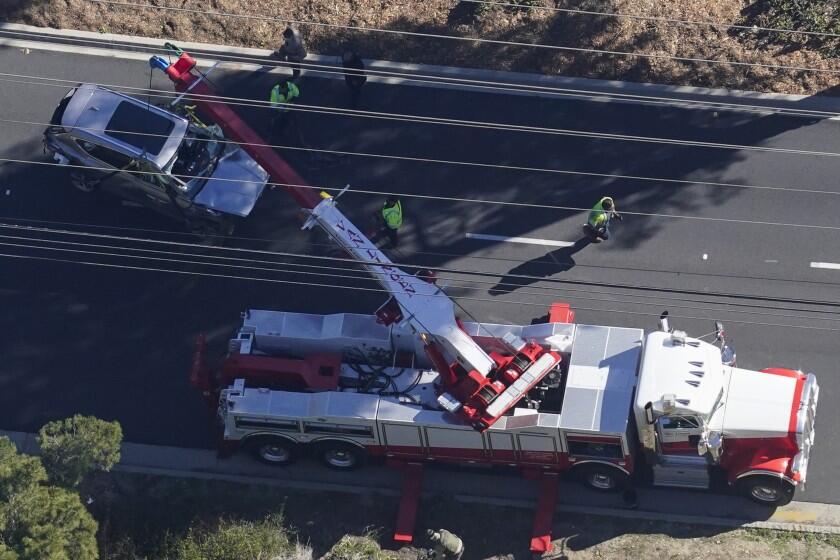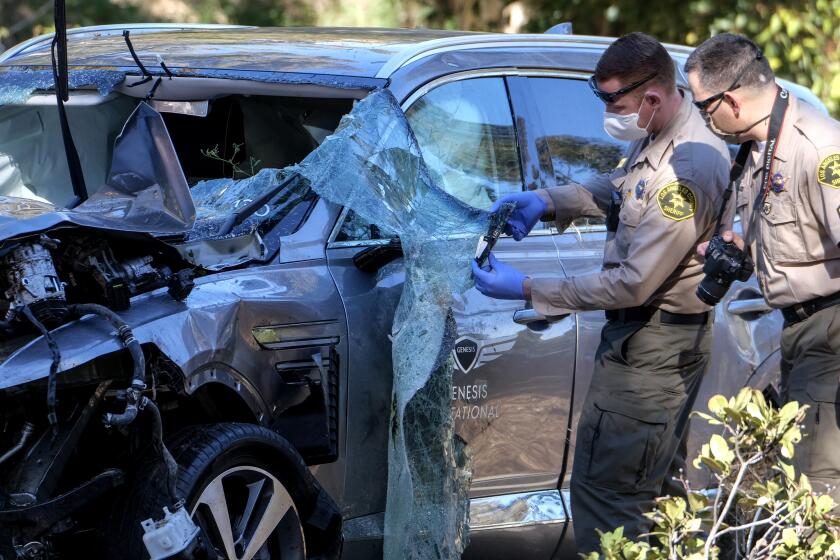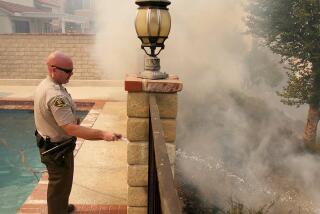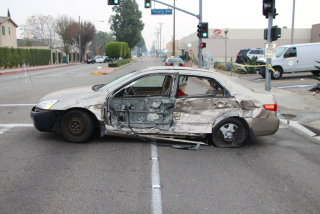Tiger Woods was driving as fast as 87 mph, nearly twice the speed limit, before he crashed

Tiger Woods was speeding when he crashed an SUV in Southern California less than two months ago, authorities said Wednesday.
Tiger Woods was driving at nearly twice the posted speed limit of 45 mph when he hit a sharp curve and crashed on the Palos Verdes Peninsula in February, the Los Angeles County sheriff said Wednesday in a long-awaited report on the accident that left the golf legend seriously injured.
Driving at an unsafe speed for the road conditions and the inability to negotiate the curve of the roadway caused the Feb. 23 crash, Sheriff Alex Villanueva said. Woods was driving a borrowed Genesis SUV when he crashed and suffered serious ankle and leg injuries, which could threaten his playing career.
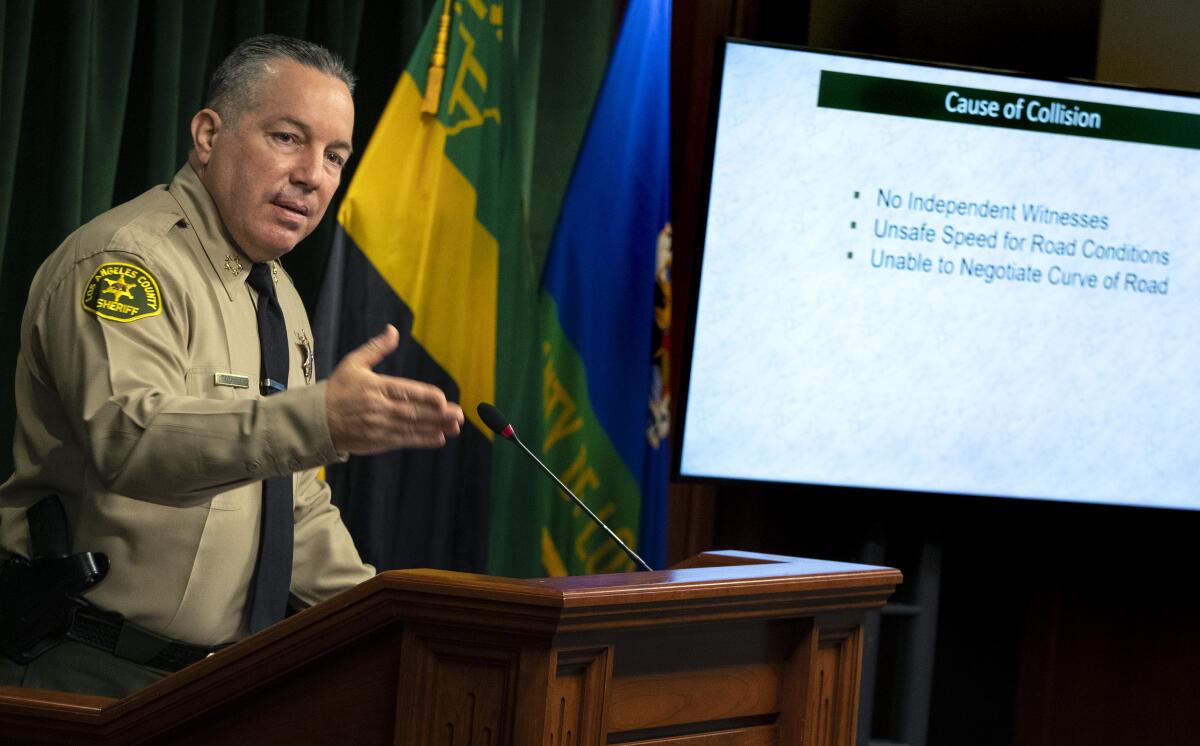
Investigators examined the SUV’s advanced data systems to determine Woods reached speeds of up to 87 mph around the time of the crash in Rolling Hills Estates. The sheriff released the information after Woods waived any objection to the release of the crash information.
Instead of reducing his speed into the curvy stretch of Hawthorne Boulevard, Woods was accelerating down the steep grade on the northbound side, which sometimes catches drivers unaware of their growing momentum.
James C. Powers, captain of the Lomita sheriff’s station that patrols the area that includes Hawthorne Boulevard, said the crash happened at 7:12 a.m. Woods hit the median, then a Rolling Hills sign, and then the west curb before striking a tree 71 feet off the roadway.
“The impact of the vehicle when it hit the tree caused it to go airborne and do a somewhat pirouette and land on its side,” Powers said.
When the airbags were triggered, the SUV’s event data recorder captured speeds before and after the initial impact of 82.02 mph to 86.99 mph.
Powers said the data recorder also captures pressure applied to the accelerator during the collision, which he said was at 99%.
“There was no evidence of braking through the collision,” said Powers, who speculated that Woods might have inadvertently “hit the accelerator instead of the brake pedal.”
By the time Woods hit the west curb the speed of the SUV dropped to 75 mph after the initial impacts, Powers said.
Villanueva noted that the stretch of road where Woods crashed is “hazardous by design” and has had “more than an average number of collisions.”
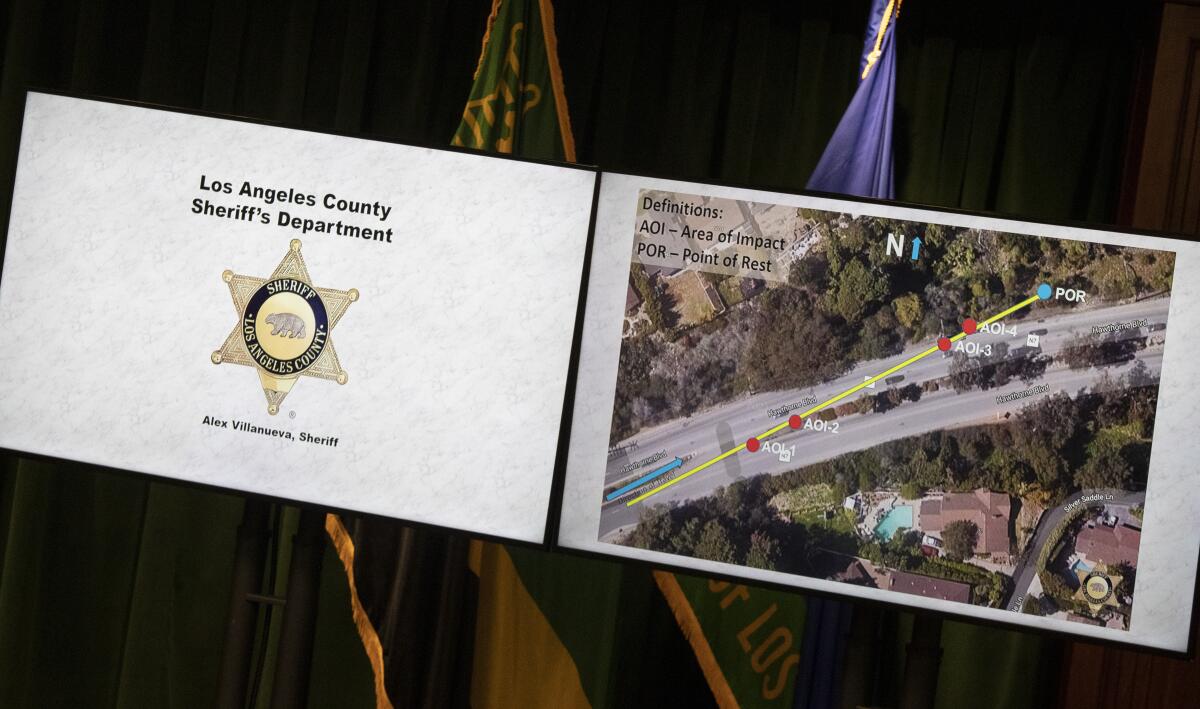
During the year before the crash, 13 other motorists crashed on the stretch, and all but two were found at fault. Villanueva has said that it is easy for a driver to pick up speed on the downhill stretch, where gravity alone creates momentum. But he also noted Wednesday that “drivers are also responsible for considering the conditions.”
Woods was staying in the L.A. area after hosting the Genesis Invitational golf tournament. He was on his way to the Rolling Hills Country Club around 7 a.m. Feb. 23 for a film shoot after spending the night at the Terranea Resort in Rancho Palos Verdes.
The road where Tiger Woods crashed has been notorious for decades. Now officials vowing to fix
Woods is now in Florida recovering from multiple surgeries.
There had been growing questions about why more information had not been released about the crash. Last week, Villanueva said that detectives had determined what caused the crash but declined to release details, citing unspecified privacy concerns.
Powers on Wednesday rejected that there was any evidence of alcohol, drug or prescription medication usage by Woods that would have provided probable cause to get a search warrant for Woods’ blood draws at the hospital. He also noted that, given the compound fracture and potentially life-threatening injuries Woods sustained at the scene, any form of sobriety assessment would not have been done.
“There was no evidence of any impairment. There was no odor of alcohol. There are no open containers in the vehicle and no narcotics or any evidence of medication in the vehicle or on his person,” Powers said.
He added that during a subsequent interview in the emergency room, Woods indicated he had not consumed any drugs or medications at the time of the crash.
The sheriff also pushed back against former law enforcement officials who have suggested Woods’ blood should have been checked.
“I know there are a lot of drug recognition experts who said they should have done this or that, and without the signs of impairment, we don’t get to the point where we can author a search warrant and develop the probable cause,” he said.
Deputy Carlos Gonzalez, the lead crash investigator in the case and the first deputy to arrive at the scene, has said publicly that he did not observe anything that led him to suspect Woods was under the influence of any substance and so had no legal grounds for testing him for alcohol, narcotics or prescription drugs. Woods was calm and lucid, he added.
Villanueva also noted that a driver’s “past history” of substance abuse doesn’t amount to probable cause. In 2017, Woods checked himself into a clinic for help in dealing with prescription drug addiction after a DUI charge in his home state of Florida.
There is a new push to examine safety issues on Hawthorne Boulevard on the Palos Verdes Peninsula after Tiger Woods was seriously hurt in a rollover crash.
Woods told investigators he had no recollection of what happened.
Powers and Villanueva also addressed why Woods was not charged with a crime or cited for reckless driving or speeding.
Powers said data from the SUV is not enough to cite Woods with speeding. The act has to be witnessed by a law enforcement officer.
The sheriff interjected. “It is a solo traffic collision... . We are not going to issue a citation for an infraction not in a peace officer’s presence. That would apply to everybody,” said Villanueva, adding that any suggestion that Woods was getting special treatment “is false.”
Dmitry Gorin, a former deputy district attorney in Los Angeles County, said that the data from the SUV’s “black box” could be used as evidence to generate a ticket. But as a practical matter, he said, law enforcement agencies require a witness of some kind to issue a speeding ticket.
Moreover, Gorin said, he was not aware of any case when a speeding ticket was issued solely with data from a vehicle’s black box.
Woods says he is focusing on his “recovery and family” after the Sheriff’s Department closed the investigation into his crash.
“I am so grateful to both of the good Samaritans who came to assist me and called 911,” Woods said in a statement Wednesday. “I am also thankful to the LASD Deputies and LA Firefighter/Paramedics, especially L.A. Sheriff’s Deputy Carlos Gonzalez and LAFD Engine Co. #106 Fire Paramedics Smith and Gimenez, for helping me so expertly at the scene and getting me safely to the hospital.”
More to Read
Sign up for Essential California
The most important California stories and recommendations in your inbox every morning.
You may occasionally receive promotional content from the Los Angeles Times.
